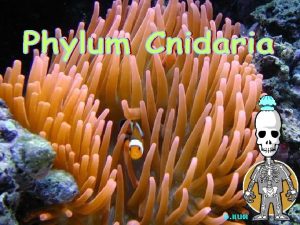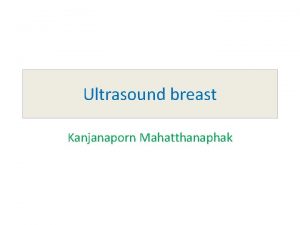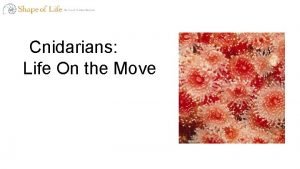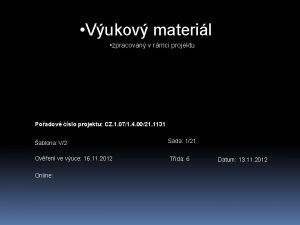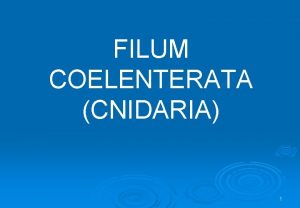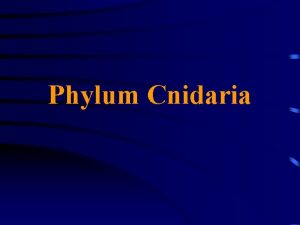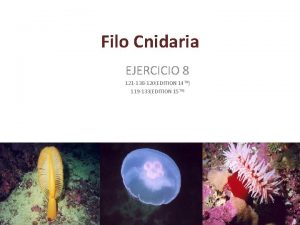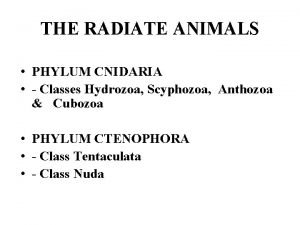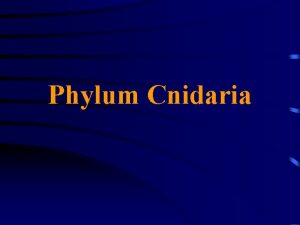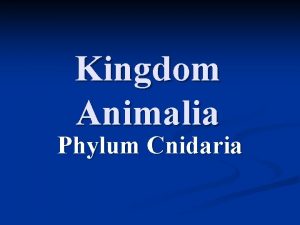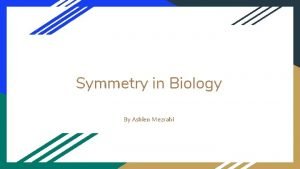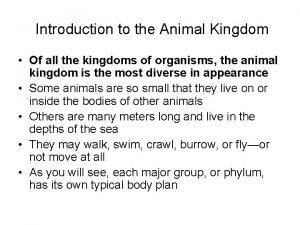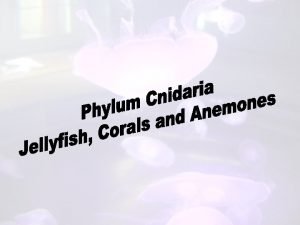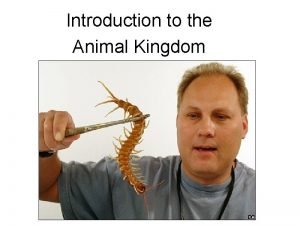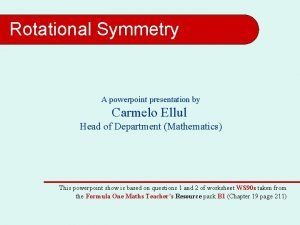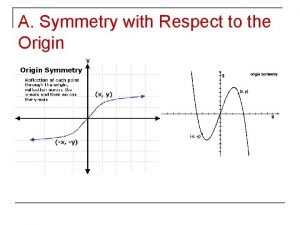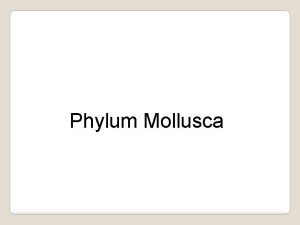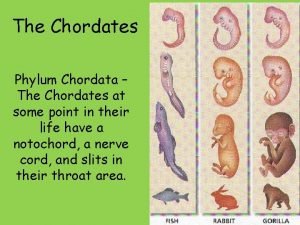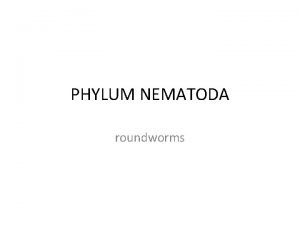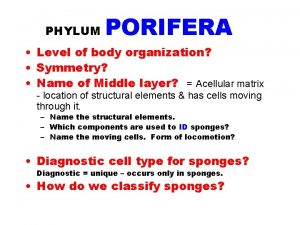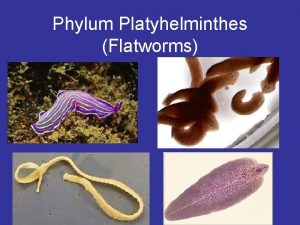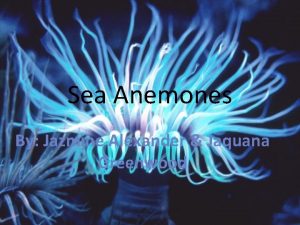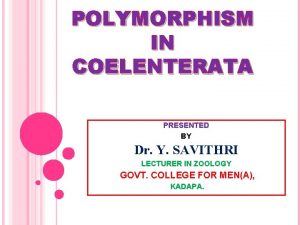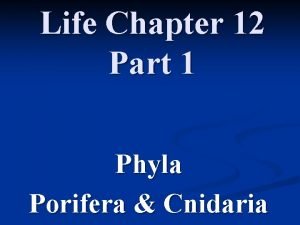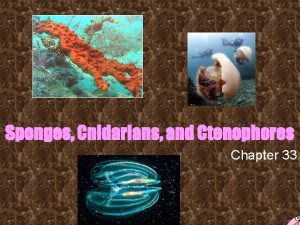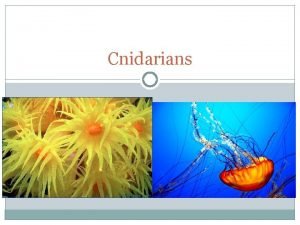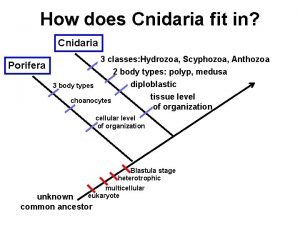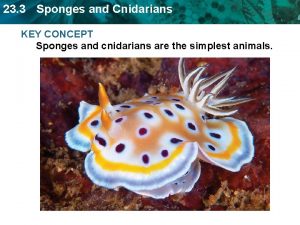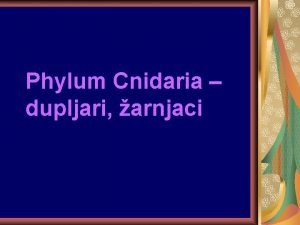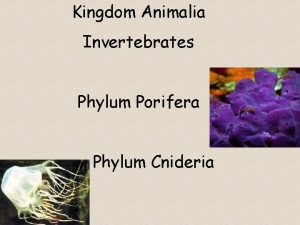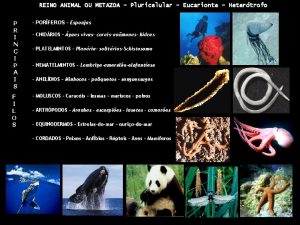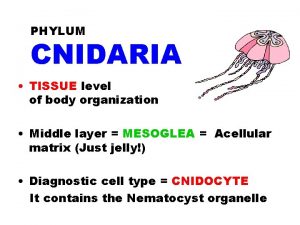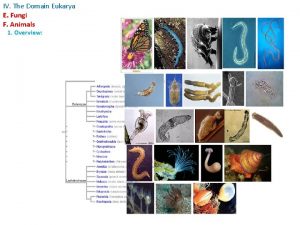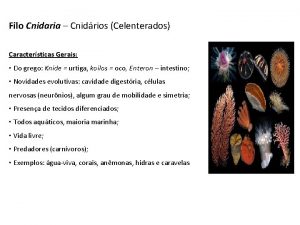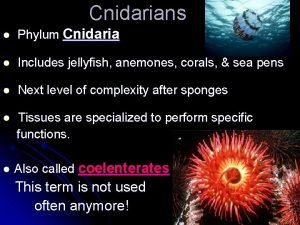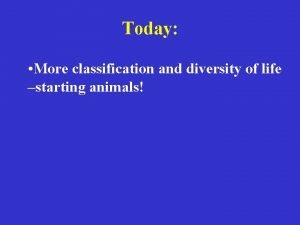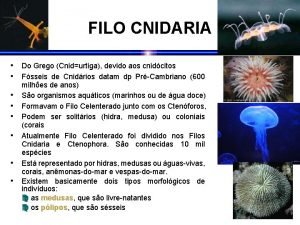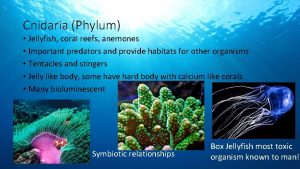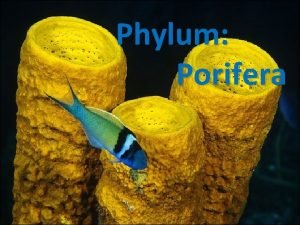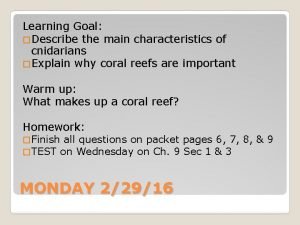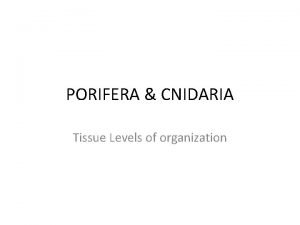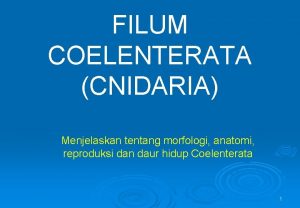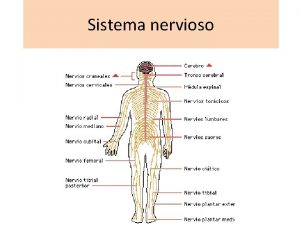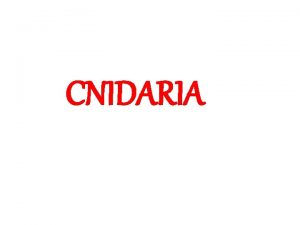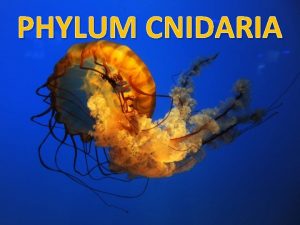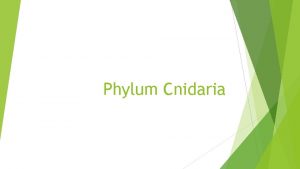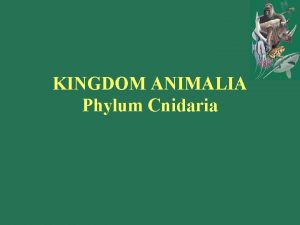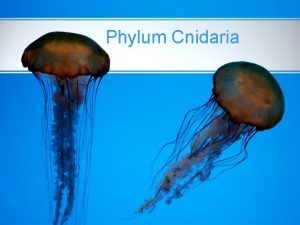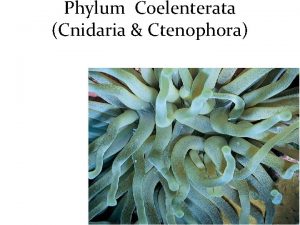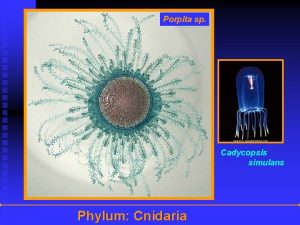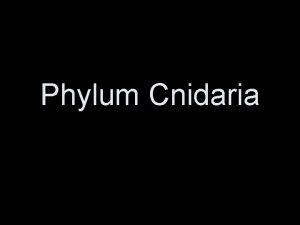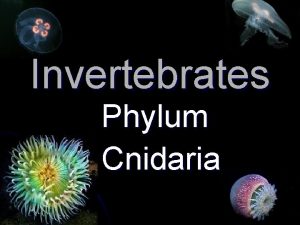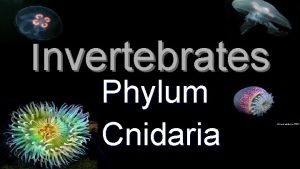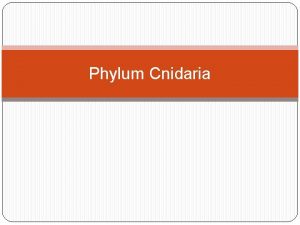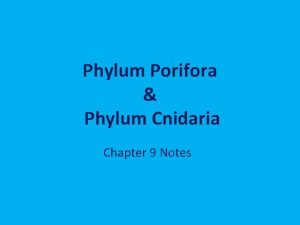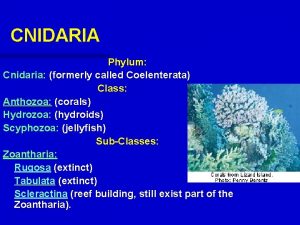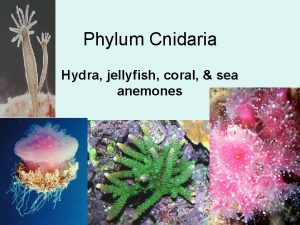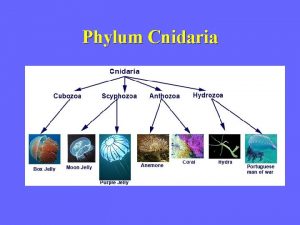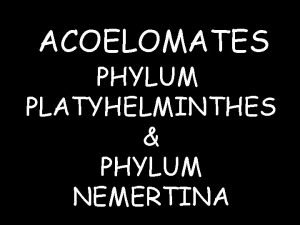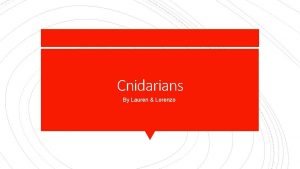Phylum Cnidaria 1 3 Phylum Cnidaria Radial symmetry






















































- Slides: 54

Phylum Cnidaria 1


3

Phylum Cnidaria • Radial symmetry • Mouth at oral end surrounded by tentacles. • One opening into and out of gastrovascular cavity. • Cnidocytes that discharge pneumatocysts • Two body forms – Polyp – Medusa • Two germ layers 4 • Nerve net

Radial symmetry 5

Mouth and Tentacles 6

Cnidarians are the oldest existing animals that have specialized tissues. • Cnidarians have two body forms. – polyps In the polyp form of a coral, the tentacles and mouth face upward.

– medusas In the medusa form of a jellyfish, the tentacles and mouth face downward.

• The four major cnidarian classes are defined by their dominant body form. – Anthozoans such as sea anemones have a dominant polyp stage.

• The four major cnidarian classes are defined by their dominant body form. – Hydrozoans such as hydra alternate between forms.

• The four major cnidarian classes are defined by their dominant body form. – Scyphozoans are jellyfish with a dominant medusa form.

• The four major cnidarian classes are defined by their dominant body form. • Cubozoans such as sea wasps have a dominant medusa form. 12

Fig. 13. 2 13

Copyright © The Mc. Graw-Hill Companies, Inc. Permission required for reproduction or display. Generalized Cnidarian Life Cycle 14

Copyright © The Mc. Graw-Hill Companies, Inc. Permission required for reproduction or display. Cnidocyte Structure and Nematocyst Discharge 15

• Cnidarians are made up of two tissue layers separated by mesoglea. gastrovascular cavity mouth • The outer tissue layer has three cell types. – contracting cells – nerve cells – cnidocytes (which contain nematocysts) discharged nematocyst barbs coiled nematocyst mesoglea tentacle oral arms

Nervous System • Nerve cells, arranged in a nerve net. 17

Class Hydrozoa • Freshwater & marine. • Cnidocytes present only on epidermis. • Medusa (if present) with a muscular velum. • Mesoglea without ameboid cells. • Asexual reproduction by budding. • Sexual reproduction via gametes produced by epidermis & released into water. 18

Class Hydrozoa • • Hydra Obelia Gonionemus Physalia 19

Class Hydrozoa Hydra Encapsulated embryo Ovaries Spermaries Sexual cycle Budding Asexual cycle 20

Hydra Body Wall Gastrovascular cavity Gastrodermis Mesoglea Epidermis 21

22

Obelia 23

Obelia Gonangium Medusa bud Medusae 24

Class Hydrozoa Gonionemus 25

Class Hydrozoa Gonionemus Velum 26

Class Hydrozoa Physalia 27

Class Scyphozoa • Tentacles up to 70 meters in length • Cnidocytes present in gastrodermis & epidermis • Thick mesoglea contains ameboid cells • Gametes produced by gastrodermis • All marine 28

Class Scyphozoa Aurelia 29

Copyright © The Mc. Graw-Hill Companies, Inc. Permission required for reproduction or display. Aurelia Life History 30

Fig. 13. 18 31

Planula Larva Ciliated larva that can swim to a new location 32

Aurelia Mesoglea Eggs Gastrovascular cavity Mouth 33

Aurelia Oral arm Gastric pouch Mouth Tentacles 34

Class Cubozoa • Medusa dominant & cuboid • Tentacles arise at four corners from blade-like pendalium. • All marine • Strong swimmers which prey primarily on fish • Stings of some may be fatal within minutes to humans. 35

Class Cubozoa Gonad Pedalium Tentacle 36

Class Cubozoa Chironex Sea Wasp 37

Class Anthozoa • Medusa stage absent • Solitary or colonial • Some produce protective skeletons • Gastrovascular cavity subdivided by at least 8 mesenteries • Cnidocytes on mesenteries • Mesoglea contains ameboid cells • All Marine 38

Class Anthozoa Sea Anemone 39

Class Anthrozoa Metridium Tentacles Mouth Pharynx Septum Gastrovascular cavity 40

Symbiosis 41

Sea Anenome Feeding 42

Class Anthozoa Corals • Protective skeleton of calcium carbonate • Polyp retracts when not feeding 43

Zooxanthellae • Photosynthetic dinoflagellates (brown) • Live in corals • Provide nutrients for coral by photosynthesis • Mutualism 44

Corals Colony of interconnected polyps 45

Class Anothozoa Meandrina Brain Coral 46

Class Anothozoa Gorgonia Sea Fan 47

Class Anothozoa Tubipora Pipe Organ Coral 48

Class Anothozoa Actinodiscus Mushroom Coral 49

Class Anothozoa Acropora Staghorn Coral 50

Coral Reefs • Formed over thousands of years from successive layers of coral skeleton deposits (calcium carbonate forms underwater mountains of coral animal skeletons) • The underwater equivalent of the amazon jungle- very high species diversity and biomass • Reefs contain sponges, colonial hydrozoans, anemones, many varieties of coral, fish, many types of worms we’ve not discussed, not to mention bryozoans, ctenophores, protists, bacteria, 51 etc. .

Copyright © The Mc. Graw-Hill Companies, Inc. Permission required for reproduction or display. Coral Reef Ecosystem Photo © Mc. Graw-Hill Higher Education, Barry Barker, Photographer 52

Cladogram of Cnidaria Anthozoa Scyphozoa Hydrozoa Cubozoa Medusa cuboidal Loss of medusa Polyp stage reduced Septa divide gastrovascular cavity Radial symmetry, cnidocytes, planula larva 53

The End 54
 Anthozoa
Anthozoa Anti radial vs radial ultrasound
Anti radial vs radial ultrasound Cnidaria symmetry
Cnidaria symmetry Větevník mozkový
Větevník mozkový Reproduction in cnidaria
Reproduction in cnidaria Cnidaria class
Cnidaria class Phylum cnidaria general characteristics
Phylum cnidaria general characteristics Gonopore cnidaria
Gonopore cnidaria Zooids in cnidaria
Zooids in cnidaria Jellyfish and sea anemone
Jellyfish and sea anemone Obelia diagram
Obelia diagram General characteristics of cnidaria
General characteristics of cnidaria Cnidaria characteristics
Cnidaria characteristics Phylum ctenophora characteristics
Phylum ctenophora characteristics Radial symmetry mandala
Radial symmetry mandala Symmetrical face
Symmetrical face Types of symmetry
Types of symmetry Radial symmetry nature
Radial symmetry nature Corals radial symmetry
Corals radial symmetry A basking shark obtains its food by
A basking shark obtains its food by Mollusca bilateral symmetry
Mollusca bilateral symmetry Symmetry ppt download
Symmetry ppt download Symmetry in respect to the origin
Symmetry in respect to the origin Symmetry in mollusca
Symmetry in mollusca Characteristics of all chordates
Characteristics of all chordates Roundworms bilateral symmetry
Roundworms bilateral symmetry Porifera
Porifera Flatworms bilateral symmetry
Flatworms bilateral symmetry Jazmine alexander
Jazmine alexander Coelenterata polymorphism
Coelenterata polymorphism Symmetry of sponges
Symmetry of sponges Section 33-2 review cnidaria and ctenophora answer key
Section 33-2 review cnidaria and ctenophora answer key Pada coelenterata klas yang tidak ada bentuk medusa adalah
Pada coelenterata klas yang tidak ada bentuk medusa adalah Jellyfish
Jellyfish Taenia solium class
Taenia solium class Cnidaria
Cnidaria Sponges concept map
Sponges concept map Phyllum cnidaria
Phyllum cnidaria Cnideria
Cnideria Pinacócito
Pinacócito Cnidaria
Cnidaria Cnidaria domain
Cnidaria domain Cladograma
Cladograma L
L Class aves
Class aves Classe hydrozoa
Classe hydrozoa Cnidaria predators
Cnidaria predators Origin of the word
Origin of the word Cnidaria tree
Cnidaria tree Characteristics of cnidarians
Characteristics of cnidarians Porifera level of organization
Porifera level of organization Porifera and cnidaria
Porifera and cnidaria Cnidaria morphology
Cnidaria morphology Section 33-2 review cnidaria and ctenophora answer key
Section 33-2 review cnidaria and ctenophora answer key Arco reflejo
Arco reflejo
